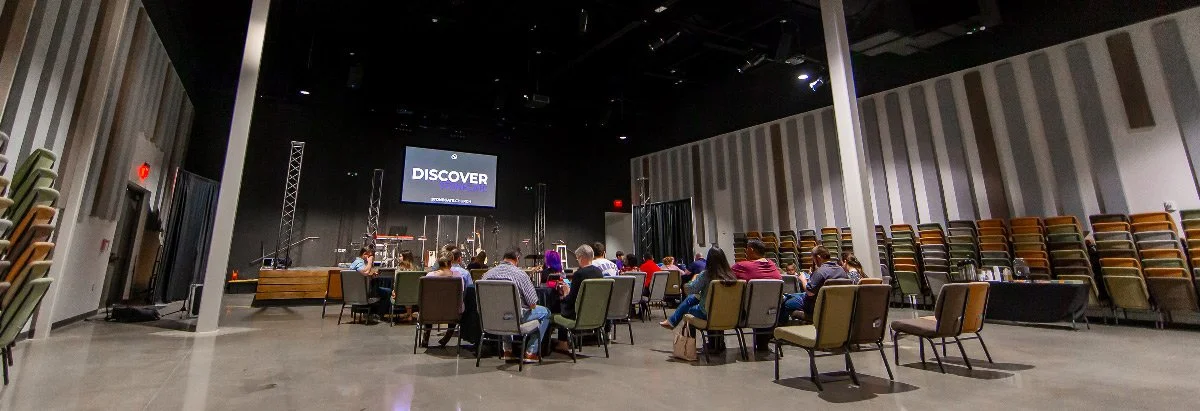6 Solutions When You’re Outgrowing Your Church Building
Every ministry goes through seasons of change. Sometimes, that change means growing pains. However, these pains do not need to be permanent or negative — they can be effective signals to help know where positive change needs to happen to continue to grow and flourish as a church.
How do I know it’s time to expand?
Maybe you can clearly see the need to expand your church. Or perhaps, you are just beginning to feel pressure points in different areas of your building. Either way, it is time to take action and decide on the best next steps for your church and people.
Here are a few triggers to watch for to weigh if expansion is the next step for your church:
You are at 80% or greater capacity in the sanctuary.
The children’s space feels excessively full.
Parking space is becoming an issue.
Foot traffic, bathrooms, and community areas feel congested.
Having an open conversation with staff and volunteers from every department and area of your church will offer up-close perspectives about how the flow, capacity, function, and space is or isn’t working on Sunday and throughout the week. Their hands-on insight is immensely valuable when considering whether it’s time to expand your church.
What are some options for expansion?
There are a variety of options to consider for your church expansion. Some of these options include using your current building but “reworking” it. Another option is finding a solution outside of your church building. And still another option, is building a new church building from the ground up.
First, consider factors such as your church’s financial situation, the timeframe you need more space, and whether or not you are looking for a short-term or long-term solution.
We will look from the shortest-term options to the longest-term solution that will give you a more comprehensive view of your decision-making. Weighing the pros and cons of “cost vs. longevity” will provide you with a better idea of which option is currently best for your church.
Shortest-term options to longest-term solution
A short-term solution will require a smaller financial investment, but remember that this solution is temporary, and you must plan accordingly. Ultimately, this transition step should lead to a long-term, more permanent solution.
A long-term solution will require a more significant up-front investment. Still, this option has many positive financial effects, such as fewer unforeseen problems, more energy-efficient systems put in place, and room to continue to grow without needing to move again.
1. Add an additional service.
Adding an additional service can help balance out the capacity of the sanctuary. If you already have multiple services on Sunday morning, consider adding one or more at different times on other days. Maximize your leadership and have others preach additional services. For example, if your sanctuary is consistently at capacity for all 2 or 3 Sunday morning services, add an additional service on Friday evening. Then, maybe Saturday morning. This will also give new opportunities for people who wouldn’t have been able to attend church on Sundays.
2. Rent a school building.
You can consider renting a school building. Being “portable” in a school can be a good option with less financial/time strain, allowing you to determine the best next steps for your church’s growth.
3. Add an overflow space.
Instead of all attendees being in the sanctuary, consider adding an overflow space where the message would be live-streamed. This still allows the church community to hear the same message, at the same time, without being limited only to the sanctuary.
When creating an overflow space, be aware of how your children’s area will be affected. With the number of people attending the service in the main sanctuary as well as the overflow room, your children’s space will remain the same size. Children’s spaces and the volunteers are usually pressed harder with this option. Parking space and bathrooms can also quickly become congested problem areas if not addressed beforehand.
4. Add a physical addition or renovation to your existing structure/property.
If you see one area of your church feeling the majority of the growth pain, consider adding additional space to that area. If the sanctuary’s size seems to be the main issue, removing walls from surrounding rooms can create a larger sanctuary. This could be an option for children’s spaces as well. If more space is needed than the church facility can offer, adding additional square footage or a standalone building for specific departments can serve the church best. Keep in mind that additional volunteers or staff may become needed.
All of these are shorter-term options that offer you and your church some additional time to decide on a long-term solution. If you have tried one or all of these options and you still feel maxed-out, it may be time to immediately consider a long-term option tailored to your specific needs.
5. Move to or convert an existing building.
Moving to an off-site location with an existing building structure is less costly than buying land and starting a new build. It will also offer a shorter timeframe for getting your church attendees settled into their new church home. Purchasing a building that was previously used as a retail store or industrial building can be an excellent option for acquiring new space without having to build it from the ground up. It can then be renovated and customized to create the needed space and areas your church currently lacks.
6. Build from the ground up.
A long-term solution is buying land and building from the ground up. When selecting this option, you can fully customize and create each area to support the ongoing needs of your church. Being able to accommodate your current attendees is essential, but it is equally important to anticipate future growth and create areas that will adapt to it.
New church builds also benefit from energy-efficient systems that allow for manageable and planned future operating costs. If this option feels the most overwhelming, don’t worry. You will not be doing this alone. A church architect helps create your own team and will guide and assist you every step of the way—from buying land and laying the foundation all the way to finishing construction and completing interior design.
Which expansion option is best for our church?
Just like the people inside your church are unique, so is your church. There is no one-size-fits-all solution for church expansion, but many options exist. Clearly identifying the “pressure points” of your church will help you know where your church needs to expand.
No matter which option you are considering, finding a church architect is extremely important. They can offer professional insight and direction for any of these options to help you decide which option is best for your church. They will also be able to help you every step of the way through your expansion project—from brainstorming to planning to completion!
Church Overflow Space Solutions FAQs
-
They are creative strategies for managing crowding, such as video venues, flexible classrooms, and multipurpose rooms that serve more than one ministry.
-
Overflow space becomes necessary when worship services are consistently full, classrooms cannot accommodate all children, or the lobby and parking areas are overwhelmed each week.
-
Often, repurposing existing spaces such as fellowship halls with video screens or modular seating can provide quick relief without major construction.
-
They are temporary solutions. While they can buy time, most churches eventually need to expand or build to sustain long-term ministry growth.
-
Multipurpose spaces and modular dividers allow ministries to serve more children safely while maintaining engaging environments.
-
They preserve a welcoming atmosphere by reducing overcrowding and preventing guests from being turned away. Thoughtful planning helps keep people connected, even if they are not in the main worship space.






